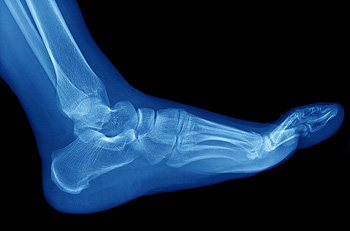Blog
How Heel Spurs Can Feel Better
 A growth on the heel that appears to have a bony texture is commonly known as a heel spur. Pain and tenderness often occur mainly because of the weight placed on the heel while walking. Obesity, poor walking and running habits, and possible hereditary conditions may be common causes of this condition, in addition to repetitive trauma inflicted on the heel. There are a few treatment options, and a crucial one is to rest the foot. Cold therapy may be another beneficial way to treat heel spurs, along with anti-inflammatory medicine. It’s important to keep the foot and ankle strong by performing specific stretches that aid in retaining mobility. An effective exercise that will help to stretch the bottom of the foot is done by pulling up on the toes and feet with your hands, then holding this position for 30 seconds. This is a beneficial treatment when repeated regularly, although it may be painful at first to perform. If you think you may have a heel spur, please consult with a podiatrist for a proper diagnosis.
A growth on the heel that appears to have a bony texture is commonly known as a heel spur. Pain and tenderness often occur mainly because of the weight placed on the heel while walking. Obesity, poor walking and running habits, and possible hereditary conditions may be common causes of this condition, in addition to repetitive trauma inflicted on the heel. There are a few treatment options, and a crucial one is to rest the foot. Cold therapy may be another beneficial way to treat heel spurs, along with anti-inflammatory medicine. It’s important to keep the foot and ankle strong by performing specific stretches that aid in retaining mobility. An effective exercise that will help to stretch the bottom of the foot is done by pulling up on the toes and feet with your hands, then holding this position for 30 seconds. This is a beneficial treatment when repeated regularly, although it may be painful at first to perform. If you think you may have a heel spur, please consult with a podiatrist for a proper diagnosis.
Heel spurs can be incredibly painful and sometimes may make you unable to participate in physical activities. To get medical care for your heel spurs, contact one of our podiatrists from Pennsylvania. Our doctors will do everything possible to treat your condition.
Heels Spurs
Heel spurs are formed by calcium deposits on the back of the foot where the heel is. This can also be caused by small fragments of bone breaking off one section of the foot, attaching onto the back of the foot. Heel spurs can also be bone growth on the back of the foot and may grow in the direction of the arch of the foot.
Older individuals usually suffer from heel spurs and pain sometimes intensifies with age. One of the main condition's spurs are related to is plantar fasciitis.
Pain
The pain associated with spurs is often because of weight placed on the feet. When someone is walking, their entire weight is concentrated on the feet. Bone spurs then have the tendency to affect other bones and tissues around the foot. As the pain continues, the feet will become tender and sensitive over time.
Treatments
There are many ways to treat heel spurs. If one is suffering from heel spurs in conjunction with pain, there are several methods for healing. Medication, surgery, and herbal care are some options.
If you have any questions feel free to contact one of our offices located in Plymouth Meeting and Ambler, PA . We offer the latest in diagnostic and treatment technology to meet your needs.
Giants Safety Collins Out Due to Ankle Injury
 New York Giants Safety Landon Collins recently suffered an ankle injury during the Philadelphia Eagles and Giants game. Collins is considered to be a great defensive player, and his loss will have an impact on the already beleaguered Giants. The Eagles beat the Giants 34 to 29. The Giants have performed poorly this season with a record of 2 wins and 12 losses, compared to the Eagles’ record of 12 wins 2 losses.
New York Giants Safety Landon Collins recently suffered an ankle injury during the Philadelphia Eagles and Giants game. Collins is considered to be a great defensive player, and his loss will have an impact on the already beleaguered Giants. The Eagles beat the Giants 34 to 29. The Giants have performed poorly this season with a record of 2 wins and 12 losses, compared to the Eagles’ record of 12 wins 2 losses.
Sports related foot and ankle injuries require proper treatment before players can go back to their regular routines. For more information, contact one of our podiatrists of Pennsylvania. Our doctors can provide the care you need to keep you pain-free and on your feet.
Sports Related Foot and Ankle Injuries
Foot and ankle injuries are a common occurrence when it comes to athletes of any sport. While many athletes dismiss the initial aches and pains, the truth is that ignoring potential foot and ankle injuries can lead to serious problems. As athletes continue to place pressure and strain the area further, a mild injury can turn into something as serious as a rupture and may lead to a permanent disability. There are many factors that contribute to sports related foot and ankle injuries, which include failure to warm up properly, not providing support or wearing bad footwear. Common injuries and conditions athletes face, including:
- Plantar Fasciitis
- Plantar Fasciosis
- Achilles Tendinitis
- Achilles Tendon Rupture
- Ankle Sprains
Sports related injuries are commonly treated using the RICE method. This includes rest, applying ice to the injured area, compression and elevating the ankle. More serious sprains and injuries may require surgery, which could include arthroscopic and reconstructive surgery. Rehabilitation and therapy may also be required in order to get any recovering athlete to become fully functional again. Any unusual aches and pains an athlete sustains must be evaluated by a licensed, reputable medical professional.
If you have any questions please feel free to contact one of our offices located in Plymouth Meeting and Ambler, PA . We offer the newest diagnostic and treatment technologies for all your foot and ankle needs.
Foot Care and Diabetes
 Foot care is extremely important to diabetics as they often suffer from neuropathy and poor blood circulation in the feet. With this in mind, if you are diabetic, always maintain proper foot care. Wear shoes that are comfortable and provide adequate support for your feet. If you travel, be sure to bring different pairs of shoes so that you have multiple options for different terrains. Twice a day, look at your feet to see if there are any abnormalities such as redness, numbness, or a wound. Wash your feet daily as well and keep them as clean as possible. Finally, maintain a healthy diet and closely monitor your blood glucose levels. If you feel pain in your feet or notice any abnormalities, see a podiatrist for a consultation.
Foot care is extremely important to diabetics as they often suffer from neuropathy and poor blood circulation in the feet. With this in mind, if you are diabetic, always maintain proper foot care. Wear shoes that are comfortable and provide adequate support for your feet. If you travel, be sure to bring different pairs of shoes so that you have multiple options for different terrains. Twice a day, look at your feet to see if there are any abnormalities such as redness, numbness, or a wound. Wash your feet daily as well and keep them as clean as possible. Finally, maintain a healthy diet and closely monitor your blood glucose levels. If you feel pain in your feet or notice any abnormalities, see a podiatrist for a consultation.
Everyday foot care is very important to prevent infection and other foot ailments. If you need your feet checked, contact one of our podiatrists from Pennsylvania. Our doctors can provide the care you need to keep you pain-free and on your feet.
Everyday Foot Care
Often, people take care of their bodies, face and hair more so than they do for their feet. But the feet are a very important aspect of our bodies, and one that we should pay more attention to. Without our feet, we would not be able to perform most daily tasks.
It is best to check your feet regularly to make sure there are no new bruises or cuts that you may not have noticed before. For dry feet, moisturizer can easily be a remedy and can be applied as often as necessary to the affected areas. Wearing shoes that fit well can also help you maintain good foot health, as well as making it easier to walk and do daily activities without the stress or pain of ill-fitting shoes, high heels, or even flip flops. Wearing clean socks with closed shoes is important to ensure that sweat and bacteria do not accumulate within the shoe. Clean socks help to prevent Athlete’s foot, fungi problems, bad odors, and can absorb sweat.
If you have any questions please feel free to contact one of our offices located in Plymouth Meeting and Ambler, PA . We offer the newest diagnostic and treatment technologies for all your foot and ankle needs.
How the Foot is Structured
The relationship between the foot and the lower leg in motion is called foot biomechanics. When the foot is structured correctly, routine activities such as walking and running should typically occur without pain. The foot and ankle combine flexibility with support, providing functions that include shock absorption of one's body weight. Additionally, this part of the body acts as a lever during the push-off period before taking a step. There are 26 bones located in the foot and ankle; these bones are maintained by ligaments and tendons, helping the arches “give” when weight is placed on the foot. Functions of the arches include supporting the weight of the body while standing. The structure of the foot is anatomically linked, resulting in even distribution throughout the foot during weight-bearing activities.
If you have any concerns about your feet, contact one of our podiatrists from Pennsylvania. Our doctors can provide the care you need to keep you pain-free and on your feet.
Biomechanics in Podiatry
Podiatric biomechanics is a particular sector of specialty podiatry with licensed practitioners who are trained to diagnose and treat conditions affecting the foot, ankle and lower leg. Biomechanics deals with the forces that act against the body, causing an interference with the biological structures. It focuses on the movement of the ankle, the foot and the forces that interact with them.
A History of Biomechanics
- Biomechanics dates back to the BC era in Egypt where evidence of professional foot care has been recorded.
- In 1974, biomechanics gained a higher profile from the studies of Merton Root, who claimed that by changing or controlling the forces between the ankle and the foot, corrections or conditions could be implemented to gain strength and coordination in the area.
Modern technological improvements are based on past theories and therapeutic processes that provide a better understanding of podiatric concepts for biomechanics. Computers can provide accurate information about the forces and patterns of the feet and lower legs.
Understanding biomechanics of the feet can help improve and eliminate pain, stopping further stress to the foot.
If you have any questions please feel free to contact one of our offices located in Plymouth Meeting and Ambler, PA . We offer the newest diagnostic and treatment technologies for all your foot and ankle needs.

